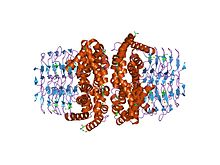Serine O-acetyltransferase
| serine O-acetyltransferase | |||||||||
|---|---|---|---|---|---|---|---|---|---|
ExPASy NiceZyme view | | ||||||||
| KEGG | KEGG entry | ||||||||
| MetaCyc | metabolic pathway | ||||||||
| PRIAM | profile | ||||||||
| PDB structures | RCSB PDB PDBe PDBsum | ||||||||
| Gene Ontology | AmiGO / QuickGO | ||||||||
| |||||||||
In
enzymology, a serine O-acetyltransferase (EC 2.3.1.30) is an enzyme that catalyzes the chemical reaction
- acetyl-CoA + L-serine CoA + O-acetyl-L-serine
Thus, the two
O-acetyl-L-serine
.
This enzyme belongs to the family of transferases, specifically those acyltransferases transferring groups other than aminoacyl groups. The systematic name of this enzyme class is acetyl-CoA:L-serine O-acetyltransferase. Other names in common use include SATase, L-serine acetyltransferase, serine acetyltransferase, and serine transacetylase. This enzyme participates in cysteine metabolism and sulfur metabolism.
Structural studies
As of late 2007, 7
structures have been solved for this class of enzymes, with PDB accession codes 1S80, 1SSM, 1SSQ, 1SST, 1T3D, 1Y7L, and 2ISQ
.
N terminal protein domain
| SATase N terminal domain | |||||||||
|---|---|---|---|---|---|---|---|---|---|
 The structure of the enzyme serine acetyltransferase- apoenzyme (truncated) | |||||||||
| Identifiers | |||||||||
| Symbol | SATase_N | ||||||||
| Pfam | PF06426 | ||||||||
| InterPro | IPR010493 | ||||||||
| |||||||||
In
Importance of function
The N-terminal domain of the protein Serine acetyltransferase helps catalyse
transgenic plants. These transgenic plants would contain more essential sulphur amino acids meaning a healthier diet for humans and animals.[3]
Structure
The amino-terminal
References
- Kredich NM, Tomkins GM (1966). "The enzymic synthesis of L-cysteine in Escherichia coli and Salmonella typhimurium". J. Biol. Chem. 241 (21): 4955–65. PMID 5332668.
- Smith IK, Thompson JF (1971). "Purification and characterization of L-serine transacetylase and O-acetyl-L-serine sulfhydrylase from kidney bean seedlings (Phaseolus vulgaris)". Biochim. Biophys. Acta. 227 (2): 288–95. PMID 5550822.

